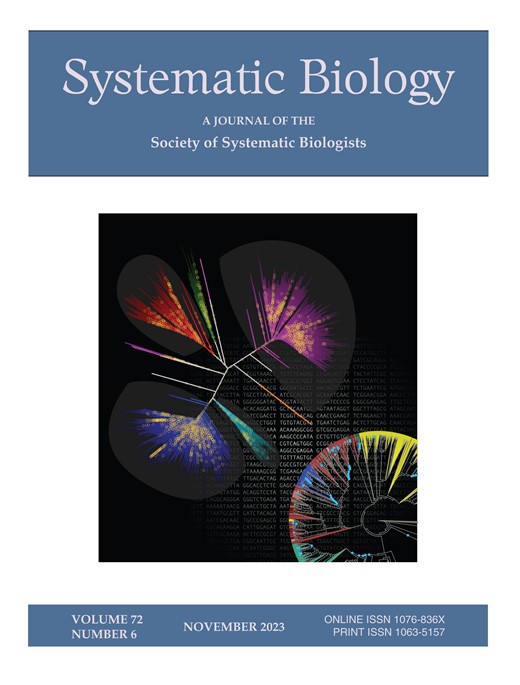Phylogenomics, Lineage Diversification Rates, and the Evolution of Diadromy in Clupeiformes (Anchovies, Herrings, Sardines, and Relatives)
IF 6.1
1区 生物学
Q1 EVOLUTIONARY BIOLOGY
引用次数: 0
Abstract
Migration independently evolved numerous times in animals, with a myriad of ecological and evolutionary implications. In fishes, perhaps the most extreme form of migration is diadromy, the migration between marine and freshwater environments. Key and longstanding questions are: how many times has diadromy evolved in fishes, how frequently do diadromous clades give rise to non-diadromous species, and does diadromy influence lineage diversification rates? Many diadromous fishes have large geographic ranges with constituent populations that use isolated freshwater habitats. This may limit gene flow among some populations, increasing the likelihood of speciation in diadromous lineages relative to non-diadromous lineages. Alternatively, diadromy may reduce lineage diversification rates if migration is associated with enhanced dispersal capacity that facilitates gene flow within and between populations. Clupeiformes (herrings, sardines, shads and anchovies) is a model clade for testing hypotheses about the evolution of diadromy because it includes an exceptionally high proportion of diadromous species and several independent evolutionary origins of diadromy. However, relationships among major clupeiform lineages remain unresolved and existing phylogenies sparsely sampled diadromous species, limiting the resolution of phylogenetically-informed statistical analyses. We assembled a phylogenomic dataset and used multi-species coalescent and concatenation-based approaches to generate the most comprehensive, highly-resolved clupeiform phylogeny to date, clarifying associations among several major clades and identifying recalcitrant relationships needing further examination. We determined that variation in rates of sequence evolution (heterotachy) and base-composition (non-stationarity) had little impact on our results. Using this phylogeny, we characterized evolutionary patterns of diadromy and tested for differences in lineage diversification rates between diadromous, marine, and freshwater lineages. We identified thirteen transitions to diadromy, all during the Cenozoic Era (ten origins of anadromy, two origins of catadromy, and one origin of amphidromy), and seven losses of diadromy. Two diadromous lineages rapidly generated non-diadromous species, demonstrating that diadromy is not an evolutionary dead-end. We discovered considerably faster transition rates out of diadromy than to diadromy. The largest lineage diversification rate increase in Clupeiformes was associated with a transition to diadromy, but we uncovered little statistical support for categorically faster lineage diversification rates in diadromous versus non-diadromous fishes. We propose that diadromy may increase the potential for accelerated lineage diversification, particularly in species that migrate long distances. However, this potential may only be realized in certain biogeographic contexts, such as when diadromy allows access to ecosystems in which there is limited competition from incumbent species.系统发生组学、品系分化率和鲈形目(鳀鱼、黑线鳕、沙丁鱼和近缘鱼类)的洄游演化
洄游在动物中独立进化了无数次,对生态和进化产生了无数影响。在鱼类中,最极端的洄游形式可能是溯河洄游,即在海洋和淡水环境之间洄游。长期存在的关键问题是:洄游在鱼类中进化了多少次,洄游支系产生非洄游物种的频率有多高,洄游是否会影响鱼系的分化率?许多溯河鱼类的地理范围很大,其组成种群使用孤立的淡水生境。这可能会限制某些种群之间的基因流动,从而增加溯河鱼类种系相对于非溯河鱼类种系的物种分化的可能性。或者,如果洄游与提高扩散能力有关,从而促进种群内部和种群之间的基因流动,那么洄游可能会降低种系的多样化率。鯡形目(鯡魚、沙丁魚、鲥魚和鯷魚)是測試溯河魚類演化假說的典範支系,因為該支系包括極高比例的溯河物種和多個獨立的溯河演化起源。然而,主要褐藻种系之间的关系仍未得到解决,而且现有的系统发生对溯河物种取样稀少,限制了系统发生统计分析的分辨率。我们收集了一个系统发生组数据集,并使用基于多物种聚合和连接的方法生成了迄今为止最全面、分辨率最高的栉水母系统发生,澄清了几个主要支系之间的关联,并确定了需要进一步研究的难以解决的关系。我们发现,序列进化速度(异型进化)和碱基组成(非稳态)的变化对我们的研究结果影响不大。利用这一系统发育,我们描述了溯河动物的进化模式,并检验了溯河动物、海洋动物和淡水动物之间种系分化率的差异。我们发现了 13 种向双向洄游的转变,均发生在新生代(10 种起源于单向洄游,2 种起源于双向洄游,1 种起源于双栖洄游),以及 7 种双向洄游的消失。两个溯河物种系迅速产生了非溯河物种,这表明溯河并非进化的死胡同。我们发现,脱离二向洄游的速度比进入二向洄游的速度要快得多。在鳞鱼类中,最大的品系分化率增长与向非洄游过渡有关,但我们几乎没有发现统计数字支持洄游鱼类与非洄游鱼类的品系分化率在分类上更快。我们认为,蓑鲉可能会增加鱼系加速分化的潜力,特别是在长距离洄游的物种中。然而,这种潜力可能只有在特定的生物地理背景下才能实现,例如,当洄游鱼类进入生态系统时,现存物种的竞争有限。
本文章由计算机程序翻译,如有差异,请以英文原文为准。
求助全文
约1分钟内获得全文
求助全文
来源期刊

Systematic Biology
生物-进化生物学
CiteScore
13.00
自引率
7.70%
发文量
70
审稿时长
6-12 weeks
期刊介绍:
Systematic Biology is the bimonthly journal of the Society of Systematic Biologists. Papers for the journal are original contributions to the theory, principles, and methods of systematics as well as phylogeny, evolution, morphology, biogeography, paleontology, genetics, and the classification of all living things. A Points of View section offers a forum for discussion, while book reviews and announcements of general interest are also featured.
 求助内容:
求助内容: 应助结果提醒方式:
应助结果提醒方式:


